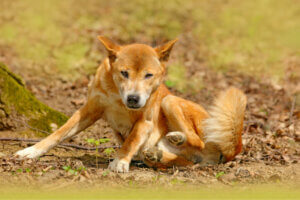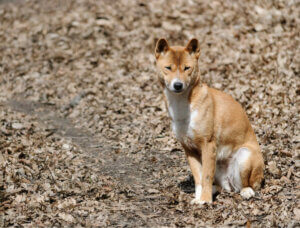The New Guinea Singing Dog Isn't Extinct

For decades, we’ve heard about curious animals that end up becoming extinct, as was the case —until now— of the New Guinea singing dog. Fortunately, in September 2020, we received information telling us that this species wasn’t extinct after all.
Have you heard about the singing dog? Do you know how it avoided extinction? If the answer’s no, then don’t worry, because we’ll tell you all about this peculiar animal and its gift now.
The New Guinea singing dog is still with us
According to news published on September 3rd, 2020, the New Guinea singing dog didn’t become extinct. This is a vitally important piece of news for the ecosystem, as we thought that this species disappeared at the beginning of the 20th century.
However, sources mention that wild specimens of this dog breed were sighted in 2016 in their natural habitat. Specifically, 15 of them were located in eastern New Guinea and in Indonesia.
This is great news for this species’ descendants from zoos or conservation centers, given that the inbreeding of specimens in captivity can be counteracted.
However, a second expedition was necessary in 2018 to collect biological samples from the animals. The objective was to genetically analyze the animals and confirm if the species really corresponded to the singing dog taxon.
Even if the answer was affirmative, we must highlight the fact that only 70% of its genome coincides with the original wild species. Experts suspect that this is due to a cross between eight types of North American dogs over several generations.

Precautions in order to avoid extinction
Moreover, the 2018 expedition provided a report on the dogs’ physiological measurements. Thanks to this continuous monitoring, researchers have been able to gather information on the health status and body condition of these wild specimens.
The experts’ task didn’t end there, as they also added GPS locators on two animals in order to register their movements and habits. Of course, the exhaustive monitoring of these wild dogs was essential in order to avoid their disappearance again.
Thanks to this research project, we expect the population of New Guinea singing dogs to increase. With care and the application of appropriate measures, we hope that this exotic animal —as well as its particular sound— can be enjoyed in the wild in a few year’s time.
Curiosities about the New Guinea singing dog
Now that we’ve given you the news, we’re going to mention some typical aspects of this fascinating canine.
Origins
The scientific name of the New Guinea singing dog is Canis lupus hallstromi or Canis familiaris hallstromi. This canid is native to New Guinea, as its name indicates.
Specifically, this canid lives in the western part of New Guinea, which belongs to Indonesia. This part receives the name of Papua, and written records show the existence of individuals of this species in this region for the first time in 1897.
The discovery of individuals of this species is a joy for the population on the island. It seemed that the breed of New Guinea singing dog had become extinct due to:
- The loss of habitat
- Crosses with the wild dogs in the villages
As for their phylogenetic position, it seems that these dogs are related to the dingo. This implies that, on an evolutionary level, they appeared before today’s modern dogs.
Knowing the particularities of this “ancestral” species allows us to expand on the current knowledge of the ancient precursors of domestic dogs, and consequently, of the different breeds of dogs that live in homes around the world nowadays.
Behavior
The study of their habits shows that these dogs are extremely intelligent as they successfully adapt to the changes in their habitat over time.
Another striking trait of this animal is its preference for high places, given its good climbing abilities. It’s also curious to know that these dogs make a specific head turn to communicate with each other.
They don’t only use their heads for this, as their long, curved and mobile tails play a part in communication. Furthermore, thanks to their fur and pattern, they can identify themselves from afar.
Do they really sing?
Even if this animal receives the common name of New Guinea singing dog, we have to explain the reason for this curious denomination. The howl of this dog is similar to that of wolves, but it also has a unique trait.
In this trait resides its authenticity, because these dogs have the capacity to modulate their own howl. Due to being able to control its vocalizations, it sounds as if the animal sings when it howls.
So, even if we tend to humanize some striking traits of animals, we can’t take them literally. However, in comparison with the rest of the Canis genus, this species does “sing” to some degree.
When analyzing their “song” through sonograms, it seems that this method of communication between singing dogs resembles that of humpback whales.

To sum up, some animals thought to be extinct may still exist. This is the case of the New Guinea singing dog, which was considered extinct since the middle of the 20th century.
Luckily, today we can still find genetically stable populations in nature as far as this species is concerned. Now it’s up to us to act in order to prevent its disappearance.
For decades, we’ve heard about curious animals that end up becoming extinct, as was the case —until now— of the New Guinea singing dog. Fortunately, in September 2020, we received information telling us that this species wasn’t extinct after all.
Have you heard about the singing dog? Do you know how it avoided extinction? If the answer’s no, then don’t worry, because we’ll tell you all about this peculiar animal and its gift now.
The New Guinea singing dog is still with us
According to news published on September 3rd, 2020, the New Guinea singing dog didn’t become extinct. This is a vitally important piece of news for the ecosystem, as we thought that this species disappeared at the beginning of the 20th century.
However, sources mention that wild specimens of this dog breed were sighted in 2016 in their natural habitat. Specifically, 15 of them were located in eastern New Guinea and in Indonesia.
This is great news for this species’ descendants from zoos or conservation centers, given that the inbreeding of specimens in captivity can be counteracted.
However, a second expedition was necessary in 2018 to collect biological samples from the animals. The objective was to genetically analyze the animals and confirm if the species really corresponded to the singing dog taxon.
Even if the answer was affirmative, we must highlight the fact that only 70% of its genome coincides with the original wild species. Experts suspect that this is due to a cross between eight types of North American dogs over several generations.

Precautions in order to avoid extinction
Moreover, the 2018 expedition provided a report on the dogs’ physiological measurements. Thanks to this continuous monitoring, researchers have been able to gather information on the health status and body condition of these wild specimens.
The experts’ task didn’t end there, as they also added GPS locators on two animals in order to register their movements and habits. Of course, the exhaustive monitoring of these wild dogs was essential in order to avoid their disappearance again.
Thanks to this research project, we expect the population of New Guinea singing dogs to increase. With care and the application of appropriate measures, we hope that this exotic animal —as well as its particular sound— can be enjoyed in the wild in a few year’s time.
Curiosities about the New Guinea singing dog
Now that we’ve given you the news, we’re going to mention some typical aspects of this fascinating canine.
Origins
The scientific name of the New Guinea singing dog is Canis lupus hallstromi or Canis familiaris hallstromi. This canid is native to New Guinea, as its name indicates.
Specifically, this canid lives in the western part of New Guinea, which belongs to Indonesia. This part receives the name of Papua, and written records show the existence of individuals of this species in this region for the first time in 1897.
The discovery of individuals of this species is a joy for the population on the island. It seemed that the breed of New Guinea singing dog had become extinct due to:
- The loss of habitat
- Crosses with the wild dogs in the villages
As for their phylogenetic position, it seems that these dogs are related to the dingo. This implies that, on an evolutionary level, they appeared before today’s modern dogs.
Knowing the particularities of this “ancestral” species allows us to expand on the current knowledge of the ancient precursors of domestic dogs, and consequently, of the different breeds of dogs that live in homes around the world nowadays.
Behavior
The study of their habits shows that these dogs are extremely intelligent as they successfully adapt to the changes in their habitat over time.
Another striking trait of this animal is its preference for high places, given its good climbing abilities. It’s also curious to know that these dogs make a specific head turn to communicate with each other.
They don’t only use their heads for this, as their long, curved and mobile tails play a part in communication. Furthermore, thanks to their fur and pattern, they can identify themselves from afar.
Do they really sing?
Even if this animal receives the common name of New Guinea singing dog, we have to explain the reason for this curious denomination. The howl of this dog is similar to that of wolves, but it also has a unique trait.
In this trait resides its authenticity, because these dogs have the capacity to modulate their own howl. Due to being able to control its vocalizations, it sounds as if the animal sings when it howls.
So, even if we tend to humanize some striking traits of animals, we can’t take them literally. However, in comparison with the rest of the Canis genus, this species does “sing” to some degree.
When analyzing their “song” through sonograms, it seems that this method of communication between singing dogs resembles that of humpback whales.

To sum up, some animals thought to be extinct may still exist. This is the case of the New Guinea singing dog, which was considered extinct since the middle of the 20th century.
Luckily, today we can still find genetically stable populations in nature as far as this species is concerned. Now it’s up to us to act in order to prevent its disappearance.
All cited sources were thoroughly reviewed by our team to ensure their quality, reliability, currency, and validity. The bibliography of this article was considered reliable and of academic or scientific accuracy.
- Rare ‘singing’ dog, thought to be extinct in wild for 50 years, still thrives. CNN News. Recogido a 11 de octubre de 2020 en: https://edition.cnn.com/2020/08/31/asia/singing-dog-found-in-wild-scn-trnd/index.html
- Mitochondrial DNA data indicate an introduction though Mainland Southeast Asia for Australian dingoes and Polynesian domestic dogs. The Royal Society Publishing, Biological Sciences. Recogido a 11 de octubre de 2020 en: https://royalsocietypublishing.org/doi/full/10.1098/rspb.2011.1395?sid=0b0c1b0d-ccc2-421c-bf94-7fe03c747cef
This text is provided for informational purposes only and does not replace consultation with a professional. If in doubt, consult your specialist.








